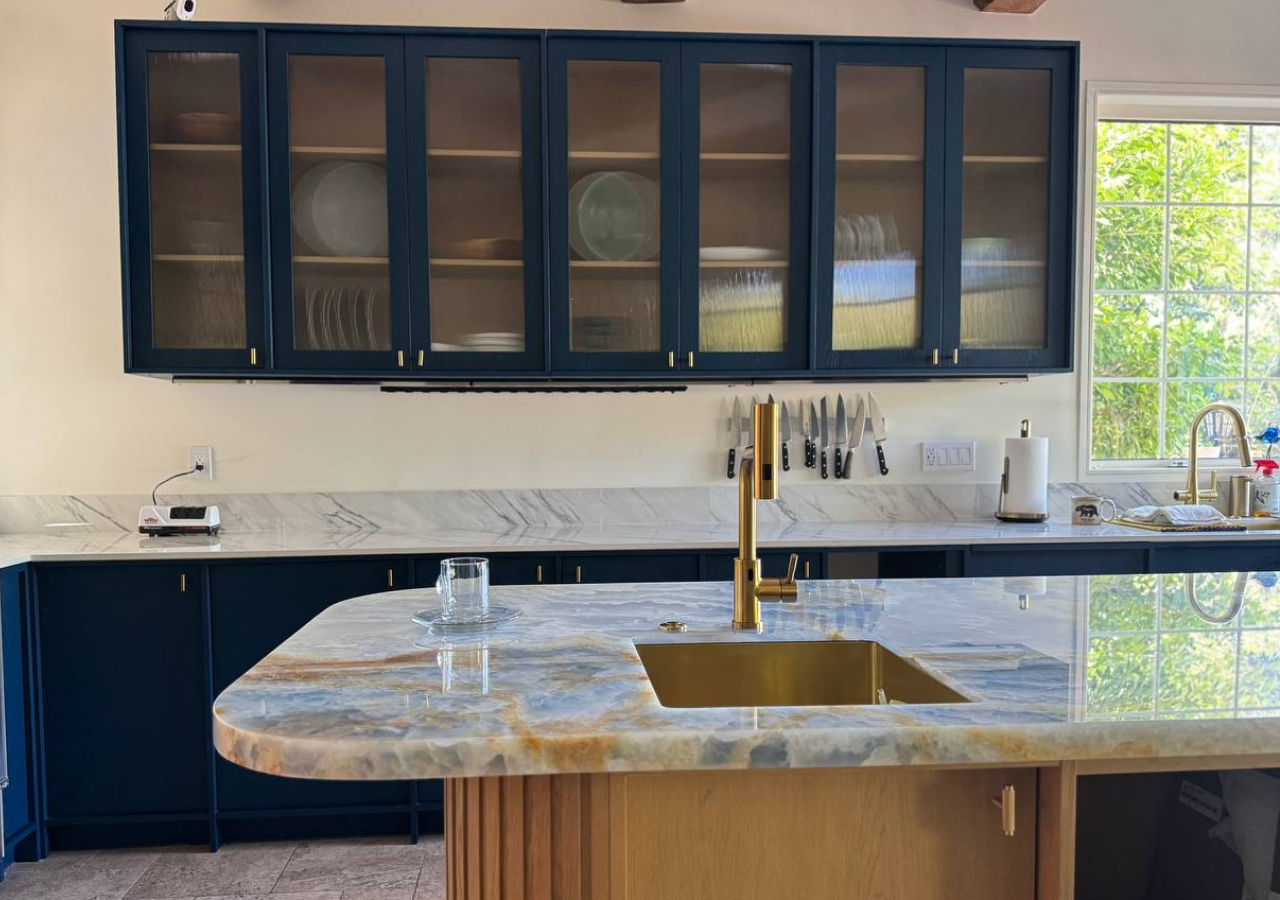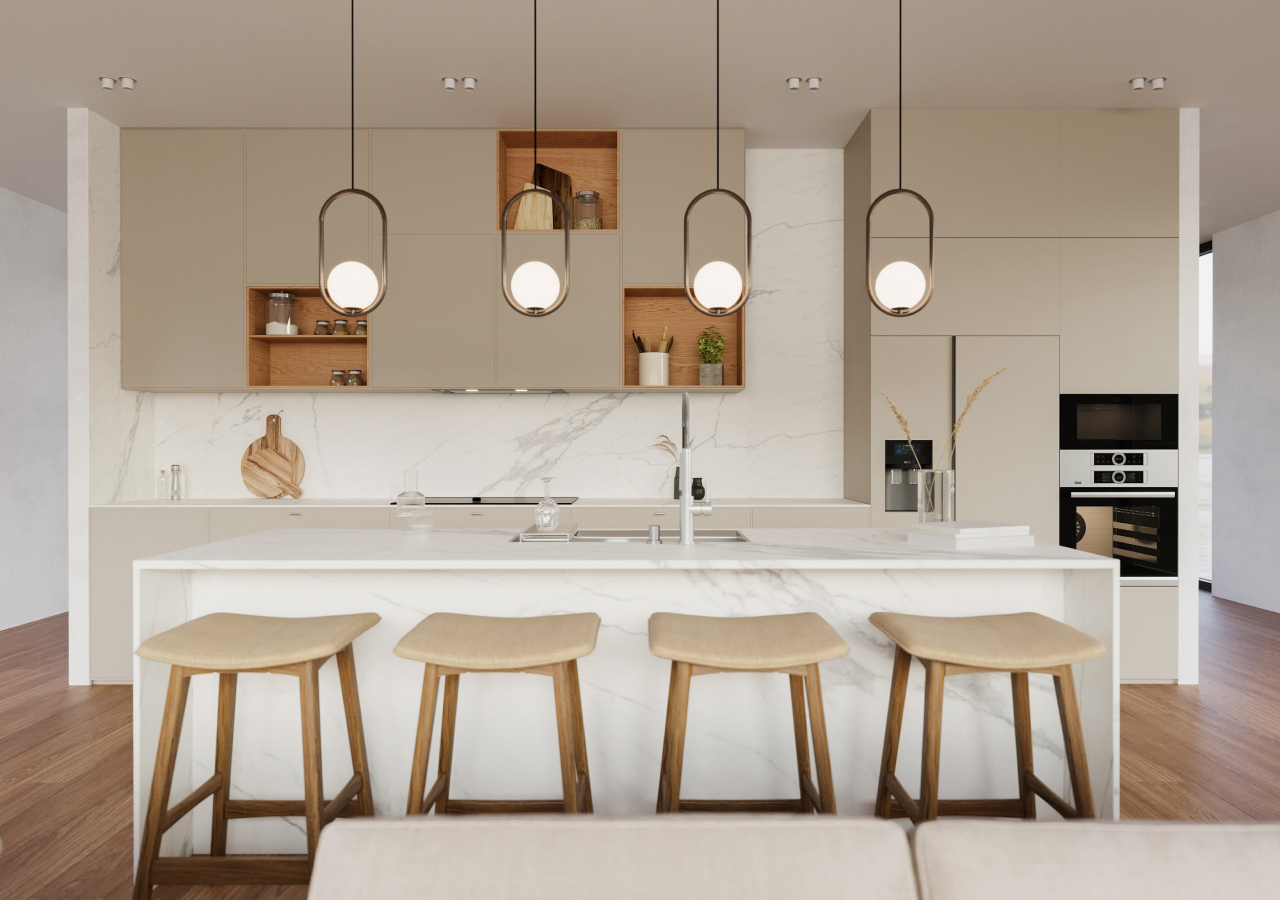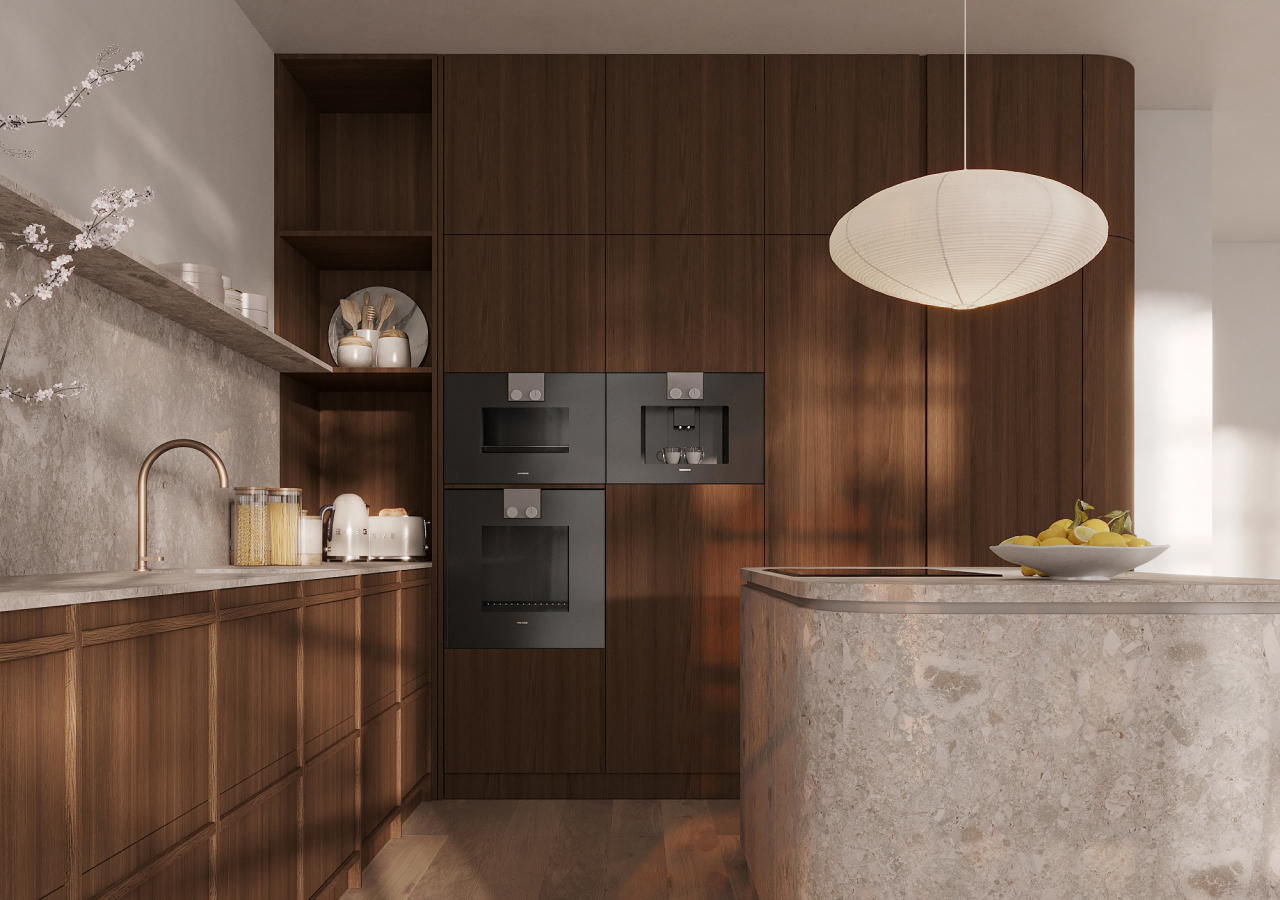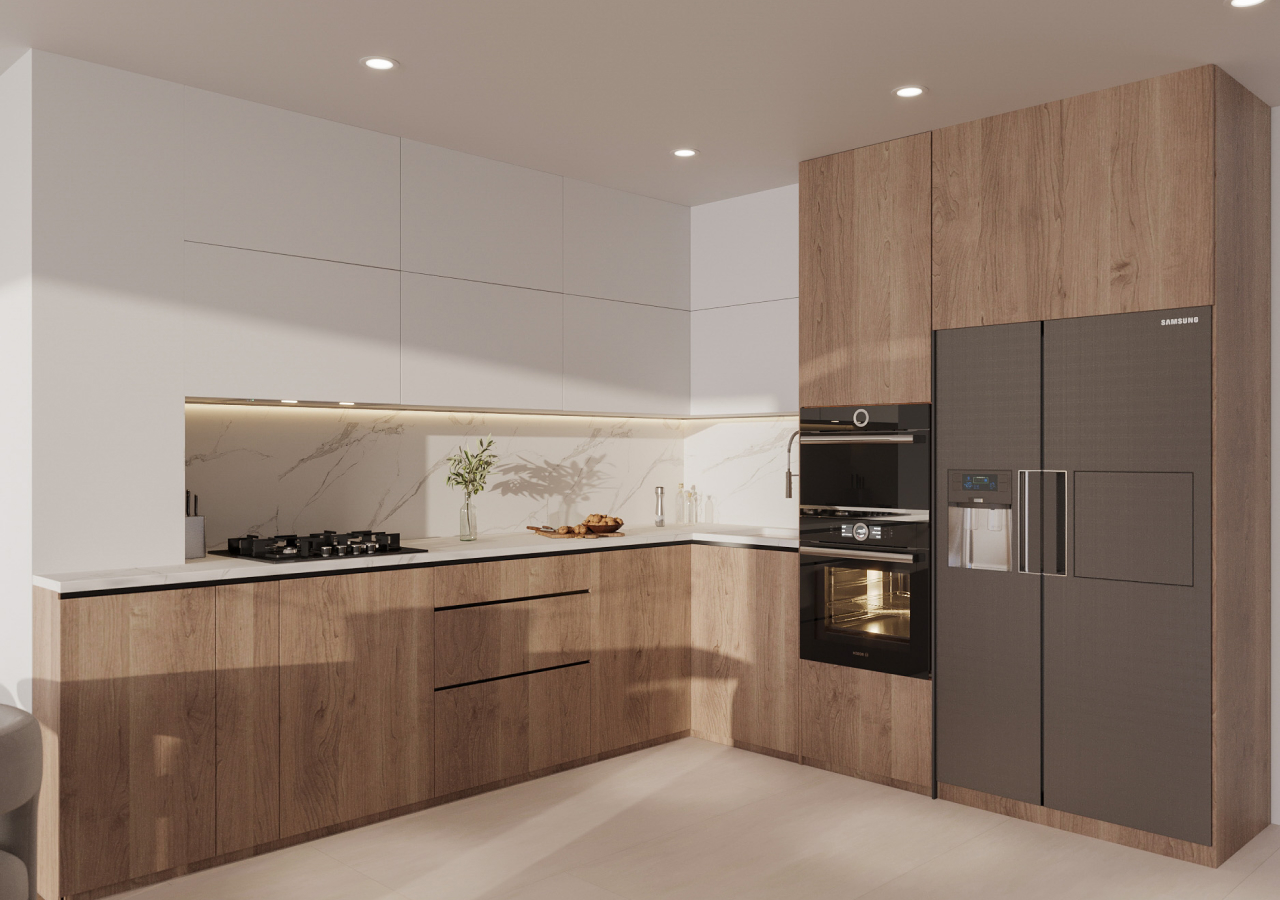The color of your kitchen shapes how the space feels—open and bright or warm and intimate. Choosing the right palette depends on light, layout, and style. This guide explains how to use the color wheel, match colors by style, and find shades that fit your space.
It is important to consider the combination of colors with furniture and finishes to ensure that the interior is harmonious. At the same time, don't be afraid to experiment, because the right choice of color will help make your kitchen unique and comfortable to use. Below, we will share recommendations to help you choose the perfect color for your space.
Understanding Color Palettes for Kitchens
When creating the perfect color scheme for your kitchen, it is important to consider how colors affect the perception of space. The right combination of shades will help create a harmonious atmosphere and visually enhance the space. To make the right choice, it is helpful to familiarize yourself with the basics of color palettes.
Color Wheel Basics for Kitchen Design

A color wheel is a circular diagram that shows all the primary, secondary, and complementary colors arranged in a specific order. It helps you understand how colors interact with each other and which ones can be harmoniously combined. The color wheel is traditionally divided into several parts:
Primary colors: Red, yellow, and blue. These are the primary colors that cannot be obtained by mixing other shades.
Secondary colors: Green, orange, and purple. They are obtained by mixing two primary colors (for example, yellow + blue = green).
Tertiary colors: These are colors obtained by mixing primary and secondary colors, such as red-orange or yellow-green.
The color wheel helps you visually perceive which colors can be harmoniously combined and which can cause dissonance.
How to Use the Color Wheel in Your Kitchen Palette
.webp)
Several approaches can help you create a balanced color palette for your kitchen. Here are the main ones:
- Complementary colors:
Colors located opposite each other on the color wheel are called complementary colors. These shades create a vivid contrast and enhance each other. For example, the combination of red and green or blue and orange. This combination gives the interior dynamism and expressiveness.
- Analogous colors:
Colors located next to each other on the circle are called analogous. These shades create smooth transitions and harmony in the interior. For example, you can use smooth transitions from yellow to green or from blue to purple. Such combinations add comfort and tranquility.
- Additional combinations:
In addition, there are more complex combinations, such as triads (three evenly spaced colors on the circle) or split complementary combinations, which create more diverse and interesting palettes.
Applying the Color Wheel to Your Space

Now that you understand the basics of working with the color wheel, you can choose shades for your kitchen, taking into account the size, style, and lighting of the room.
- Light shades:
Light colors such as white, beige, and light gray create a feeling of space and airiness. These shades are ideal for small kitchens, where it is important to visually expand the space and enhance natural lighting.
- Dark shades:
Dark colors, such as dark blue, dark gray, or dark green, add depth and elegance. They are ideal for spacious kitchens and can be complemented with wood or metal elements to create contrasting accents.
- Warm shades:
Earth tones such as sand, terracotta, and olive green create comfort and warmth. These colors are perfect for country or rustic kitchens, where it is important to emphasize the atmosphere of home comfort and harmony.
- Bright accents:
If you want to add personality, use bright accent colors such as rich red or deep green. These shades can be used in details such as aprons, countertops, or decorative elements, creating interesting contrasts and emphasizing the overall color concept.
Choose Kitchen Colors by Style
Choosing a color that matches the style of your kitchen plays a key role in creating a harmonious and cozy atmosphere. Whether you've chosen a minimalist, Scandinavian, Japandi, or wabi-sabi style, the right shade will emphasize the individuality of your interior. Also, don't be afraid to mix styles and colors to create a unique and personalized design.
Minimalist Kitchen Colors

Neutral and understated shades such as white, gray, black, and pastel tones are ideal for a minimalist kitchen. These colors help create a calm and clean atmosphere, which is especially important in an interior where the emphasis is on simplicity and functionality. Monochrome palettes and clean lines can be complemented with metallic accents or glass to create a more elegant and modern look.
Modern Kitchen Color Ideas
.webp)
Modern kitchens often combine simplicity and sophistication, which is perfectly supported by neutral colors: white, gray, and black. These colors create an elegant and clean look, ideal for kitchens with minimalist designs and industrial-style elements. You can enhance the effect by adding stainless steel, glass, or concrete details to create a more stylish and modern interior.
Scandinavian Kitchen Color Palette

Light and natural shades—white, gray, beige, and pastel tones—look perfect in Scandinavian kitchens. These colors help maximize light in the room and create a light, airy atmosphere. These shades go well with natural wood, which adds warmth and comfort. This style, inspired by northern nature, is particularly suitable for creating spacious and minimalist kitchens.
Japandi Kitchen Colors

The Japandi style combines elements of Japanese and Scandinavian design. Warm neutral shades such as gray, beige, dark green, and brown are ideal for this type of kitchen. These colors create an atmosphere of calm and harmony, which perfectly matches the philosophy of minimalism and Japanese aesthetics. Add wooden accents or textures to enhance the natural atmosphere and create a cozy space.
Wabi-Sabi Kitchen Colors

Wabi-sabi is a Japanese philosophy that values imperfection and naturalness. For a Wabi-Sabi-style kitchen, choose earthy and muted shades such as terracotta, olive, gray-green, and beige. These colors emphasize the connection with nature and create an atmosphere of comfort and tranquility. Wabi-sabi kitchen uses textured materials such as wood, stone, and ceramics to create a harmonious and relaxing interior.
Kitchen Colors by Size & Lighting
Color influences how spacious or intimate a kitchen feels. Light tones reflect brightness and make compact rooms feel larger, while deeper hues anchor open spaces and add warmth.
When choosing colors for your kitchen, it is important to consider not only the style, but also the size of the room and how natural light enters it. The right shades can significantly change the perception of space, making it visually more spacious or cozy, as well as enhancing the effect of lighting. By skillfully combining colors, you can create a harmonious and comfortable interior that will perfectly match the size and lighting of your kitchen.
Best Colors for Small Kitchens

In small kitchens, it is important to choose shades that will help to visually expand the space. Light colors such as white, light gray, pastel shades, and beige reflect light and make the room more open and airy. These shades create a feeling of spaciousness, especially if the space is limited or there is not enough natural light. To add interest and personality, you can use accent colors in small details: on countertops, backsplashes, furniture, or accessories. This approach will liven up the interior without overloading it.
Best Colors for Large Kitchens
.webp)
Large kitchens provide more freedom to experiment with colors, allowing you to combine both light and more saturated shades. Deep colors such as dark blue, dark gray, or dark green are ideal for creating a cozy and luxurious atmosphere. These shades help to create an atmosphere of seclusion and sophistication. Combined with lighter details, such as kitchen islands or walls, they balance the space and add contrast. For contrast, you can use light wood, such as light oak, to create interesting accents.
How to Use Color to Optimize Space

For small kitchens, choosing the right color is especially important to make the most of the space. Light colors, such as white or light gray, reflect more light and make the kitchen appear more spacious. In narrow or dark kitchens with low ceilings, a neutral color palette will help expand the space, making it more open and bright.
However, this does not mean that bright colors should not be used in a small kitchen. For example, an accent wall in a bright shade can add interest and depth even to a compact space. Another popular solution is a two-tone color scheme, where darker colors are used for the lower cabinets and floor, and lighter shades for the upper cabinets. This combination will create depth and style without overloading the space.
Here’s a simple step-by-step process for choosing your kitchen color:
1. Define your kitchen style.
2. Assess natural light and space.
3. Select a main tone and two complementary accents.
4. Test samples under different light.
5. Finalize finishes and materials.
Conclusion
The right colors, chosen to suit the size and lighting of your kitchen, can significantly change the perception of space. Light shades are ideal for small rooms, while deep, rich colors will help add comfort and elegance to large kitchens. It is important to remember that the choice of color always depends on the effect you want to achieve: to expand the space, add comfort, or create a balance between light and dark accents.

.webp)



